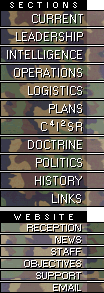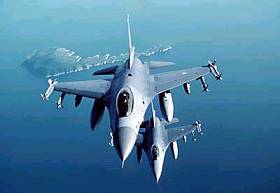





Netherlands Looks To Replace F-16s Earlier Than Proposed
December 26, 2001

he Air Force's F-16 fighter aircraft may last much longer than the Defense Ministry is currently claiming. Defense Ministry statistics show that the oldest aircraft will not reach their maximum number of permitted flying hours in 2010, but only in 2020.
The Defense Ministry wants to gradually replace the F-16s as of 2010. This replacement will cost at least 12 billion guilders and will thus be the largest Dutch military order ever. All documents that the Defense Ministry has so far forwarded to the Second Chamber claim that the oldest F-16s will reach "the end of their operational, technical, and economic lifespan" by 2010.
It is claimed that, as of 2010, the F-16s would no longer be competitive and so worn out that maintenance costs would exceed the purchase cost of new aircraft.
The cabinet will have to decide in the very short term whether it wants to participate, to the tune of 1.8 billion guilders, in the development of the US Joint Strike Fighter [JSF], the likely successor of the F-16s. This would allow Dutch industry to participate in the construction of the JSF, which will enter the manufacturing phase as of 2010. According to a powerful industrial lobby, this would give Dutch industry access to 10 billion to 15 billion guilders in orders.
Because of the high initial investment required, a decision to participate in the development phase would imply that the Netherlands will subsequently also purchase the JSF, State Secretary Van Hoof (defense) already said earlier this year. This week, the JSF's competitors, French aircraft manufacturer Dassault and the UK/German/Spanish/Italian Eurofighter concern, urgently requested the Netherlands Government to postpone its decision on the JSF.
The Netherlands possesses 136 operational F-16s. The oldest aircraft date from 1981. In August 2000, each plane had averaged 2,952 hours in effective flying time, so they still have some 3,000 more hours to go. So as to reach a total of 6,000 hours by 2010, the planes should effectively fly some 300 hours per year. Over the past few years, this number has never been achieved.
A Defense Ministry spokesperson admitted that the annual number of flying hours is decreasing. However, the spokesperson also added that the aircraft's technical lifespan is not only determined by the number of flying hours. He said that the F-16s wear out faster than anticipated, which leads to ever-increasing maintenance costs. Therefore, he deems it "possible in principle" that the oldest F-16s will be "phased out" before having completed 6,000 flying hours.
So far, the Defense Ministry standard for determining an aircraft's "maximum technical lifespan" has been 6,000 flying hours per aircraft. Last year, for instance, Van Hoof wrote in an explanatory memorandum in answer to questions from the Chamber that Dutch F-16s "with an average number of 6,000 flying hours" would be replaced in the 2010-2025 timeframe. However, Defense Ministry statistics also show that the oldest F-16s will not reach this maximum by 2010, but only by 2020 due to the decrease in flying hours carried out by the Air Force.
The 2002 defense budget shows that, during 2000, each F-16 had been scheduled to fly 177 hours on average, but due to high fuel prices and the high dollar rate, only 143 hours were effectively carried out. This is fewer than three hours per week. For 2001 and 2002, the defense budget has earmarked funding for 161 flying hours but, due to the ever-increasing operational costs, it is not at all certain that this number will be reached. At an average of 150 flying hours per year, the oldest F-16s will reach their maximum of 6,000 hours shortly after 2020. The newest aircraft, which were procured in 1992, will reach the end of their technical lifespan in the 2025-2030 period.
Last year, Van Hoof said that the replacement of the F16s' could "in no way whatsoever" imply the "acceptance of a shorter lifespan for the Dutch F-16s."
Text source: Rotterdam NRC Handelsblad, December 8, 2001
© 2001 CheckPoint |














